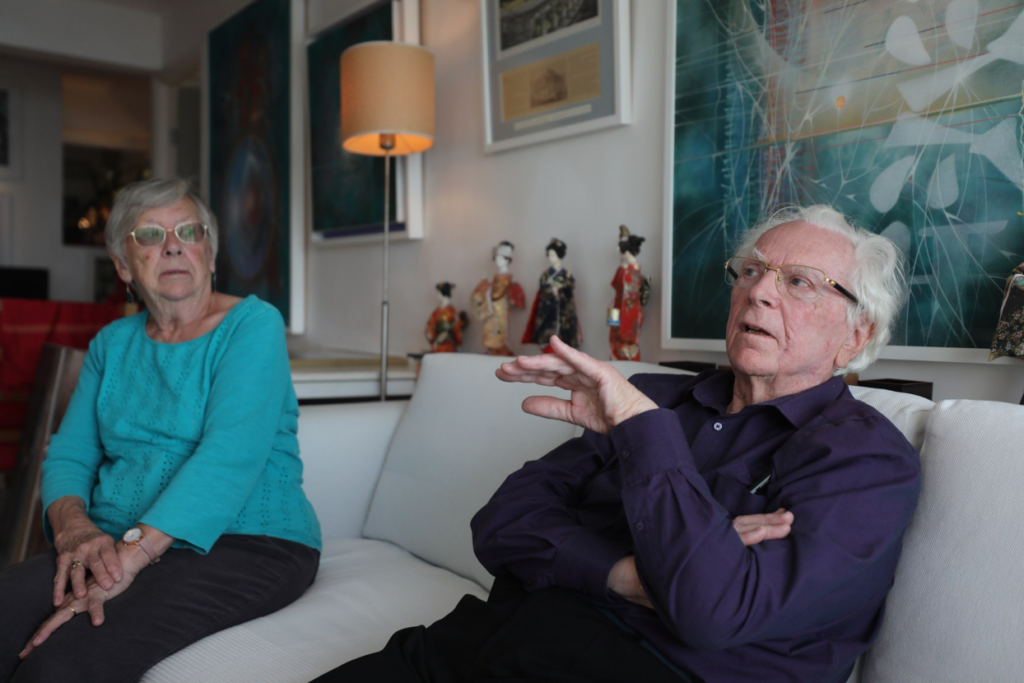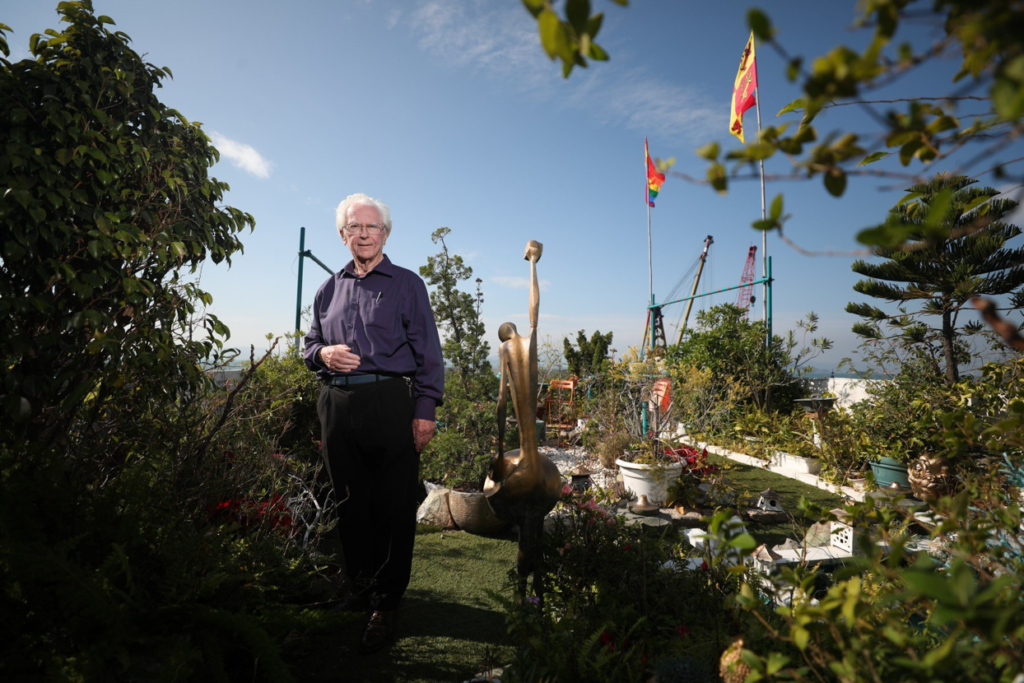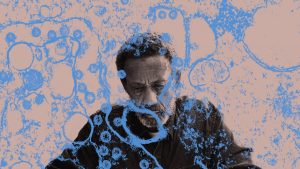Brian Tilbrook’s first Hong Kong art show was in the 1960s. As he puts the finishing touches to works for a new one, he reflects on a lucky life spent in Asia
Brian Tilbrook – artist, set designer, former teacher and long-term Hong Kong resident – turns 90 on February 18, which is also the day an 11-week exhibition of his work was due to open at the University Museum and Art Gallery at the University of Hong Kong. The gallery is currently closed because of Covid-19 restrictions but Tilbrook is confident it will, eventually, open.
“It doesn’t bother me in the slightest if it’s six weeks or five weeks,” he says. Clamouring for space is not an unknown concept for Tilbrook: “I’ll even settle for two weeks.”
In the old days – before the Hong Kong Museum of Art, or M+ – there was never enough space for Hong Kong exhibitions. A lottery would be held for the brief, prime slots at City Hall.
The genial, fresh-faced Tilbrook recalls “the manager drawing my name out of the bag and saying, ‘Oh, Brian! You’ve got the plum week’”. Here, the artist gives a tiny frown and murmurs, “He shouldn’t have said that, he should have said, ‘Mr Tilbrook’ … That was the best allocation at the time. I’d have hated other artists standing around to think I’d been given preferential treatment and I don’t think I had.”
Tilbrook’s first City Hall exhibition was in January 1968 (it ran for a week) and included paintings that had been originally commissioned by the Mandarin hotel for British Week, a 1966 trade promotion graced by Queen Elizabeth’s sister, Princess Margaret. Tilbrook has had a long relationship with hotels, banks and offices in Asia. He used to have a Cathay Pacific name card that described him as the airline’s “travelling artist”.
And yet much of Tilbrook’s work is no longer visible. Either the owners have left or the buildings have been demolished, although, in this city, glimpses remain in Pacific Place, Central Plaza and the Hong Kong Club. For the HKU exhibition, he has borrowed – or made a few photographic prints of – the originals; and almost until the moment the collection sailed from Lamma to what he calls “the mainland” of Hong Kong Island, he was creating new pieces.
“I’ve still got to do the final touches on that one, my first reaction to global warming,” he says, one recent afternoon, pointing to an unnamed painting propped against the wall in his home, where he lives with Moyreen, his wife of almost 60 years. The tableau suggests conflagration, scorched buildings, a scene raked by lines of what could be financial charts or collapsing debris, which he says represent the scars of “burnt ambition”.
Early Tilbrooks were often meticulous depictions of Asian cultural sites – in Cambodia, Laos, Macau – but even then, he inclined towards the abstract. Any lean towards realism was finally killed off, he says, by the year he spent painting 50 heritage sites for a 1989 colonial-era government book called Hong Kong Heritage (foreword by Jan Morris).
He has always loved to create trees, however, and at the bottom of the new work he has placed a piece of coral, acquired years ago before coral harvesting became questionable. He’s blackened it with acrylic spray paint: the death of growth. There is also, as there often is in Tilbrook’s abstracts, a circle. It glows hot white, he explains, “so that you could almost burn your fingers on it”.
On the door of an upstairs room is handwritten in wobbly script: Almost private studio of sorts more or less. He’s stuck an artist’s palette to it – a private joke of sorts, as he says “I’ve never used one in my life, I thought it was a little bit precious.”
In the corner, above his own work, hangs a small rural oil painting by his father, Reginald. Long ago, father and son used to go on countryside expeditions in Middlesex, in southeast England. “If you stood now where that ladder is,” he remarks, pointing to the painting’s vanished haystack in Hounslow, “you could be run over by a jet at London airport.”
When Brian was a boy, he and his older brother used to receive a penny each as weekly pocket money. Before it was handed over, his father would hold it up: the goddess Britannia on her throne, gripping what used to be called the Union Jack. His father would draw a circle. Then he’d tell the boys to draw a circle, too.
Reginald was a bus conductor whose work was sometimes shown in London’s high-end galleries. On the pantry wall next to his Lamma studio-of-sorts, the younger Tilbrook has assembled a montage of newspaper cuttings about his father’s 1930s exhibitions.
The press liked the artistic-conductor angle. “Brush hour is the busiest time of the day for Mr. Reginald Tilbrook …” as the droll correspondent from the Daily Mirror put it in 1937. Young Brian, aged five, stares sternly at the camera while his father pretends to be daubing a canvas, clad in his uniform.
A decade later, Brian, by then a pupil at Spring Grove Grammar School and showing every sign of inherited artistic promise, was chosen to design the scenery for a production of The Merchant of Venice, the first of many stage sets.
Spring Grove was a large 18th century mansion that used to belong to the Pears – as in Pears soap – family. He was given a stable loft in which to work. It was, he remembers, “the size of a bowling alley”, the largest studio he would ever have in his long life.
His father suggested he use some old London Transport black roller blinds on which to paint a Venetian backdrop. These usually advertised destinations and services on the front of London’s buses (when backlit on the opening night, it was apparent that Brian’s blinds still carried details about bus hire).
Nevertheless, access to that spacious stable loft, the school’s encouragement and, most of all, witnessing the early magic of his father’s creativity eventually transported him to Ealing Art College. Several of his teenage paintings of scarred, post-war 1940s London survive, including one of the ruins behind St Paul’s Cathedral.
A previous work, called Kids’ Paradise, which he still has on Lamma, shows a bomb site brick wall on which children have chalked a cricket wicket. Viewing it now, the title and subject matter seem oddly prescient because it was a cricket match, in the summer of 1953 while he was on National Service, that introduced him to a new world. A cricket ball broke his finger, which in a Tilbrook painting, would be the circle of destiny.
His comrades were sent to Catterick, in North Yorkshire, but Brian, having rested his finger, boarded the Empire Orwell to sail for Korea, where the war between North and South had reached the pause in hostilities at which it remains. By chance, the troopship ahead of his had become stuck on a sandbank and he was obliged to disembark in Japan. He marvels at the randomness. “If it hadn’t been for that sandbank … from there unfolded a fairy tale.”
He was sent to Kure, a naval port about 20km from Hiroshima. It had been eight years since the atomic bomb had almost obliterated the city. Early on, out for a walk, he saw what he describes as “the perfect shadow of a human being, engraved by atomisation” on to stone. (It’s now in the Hiroshima Peace Memorial Museum.)
Did he paint that scene? “No. I took photographs but I never painted anything in Japan except what I thought was beautiful, like the fishing boats and the old houses.”
While he was there, he designed a cinema on the base. That was a form of set design: “I had to give those young men a belief that they were back at home in the Odeon, not in Japan.” They named it The Tilbrook in his honour. After he returned to England, Japan still filled his head. He longed to get back.
He went to Hornsey College of Art, then taught in a grammar school. “Lovely people, lovely kids, as perfect as you could want.” He became a follower of the philosopher George Gurdjieff, whose method, called The Work, trained people to develop their consciousness in a way that combined belief systems from both East and West.
Gurdjieff had died in 1949 but his acolytes continued his mission. After four years, Tilbrook, who’d initially been enamoured with the Gurdjieff group, was on the cusp of disillusion. “They developed a music and movement side and as Moyreen will tell you, a worse dancer it would be hard to find.”
One day, in 1962, a British colonel who’d been based in Kure rang to ask Tilbrook if he would teach art at the Bourne School – officially the British Army Children’s School – in what was then called Malaya. He was told to reply within 24 hours; within two, he’d said yes. He couldn’t have pinpointed Malaya on a map but he knew it was closer to Japan. On the plane to Singapore, and then the 27-hour train journey to Kuala Lumpur, was a young woman who would be the school’s new history teacher. This was Moyreen.
They were married at the end of their first year. At the end of their second, they moved back to Britain. “We’d never met each other’s parents,” Moyreen explains. After 10 months, they fled – her verb – English suburbia and, in 1965, came to Hong Kong.
Brian took up a post in the art department at St George’s School, which closed in 1996 and is not to be confused with King George V School. (“They’re merely a king – we were a saint,” as he likes to say.) Moyreen taught history for four years at St Paul’s in Causeway Bay until their children – girl, boy, boy – arrived in quick succession.
From the moment he landed in Hong Kong, Tilbrook became involved in theatre design (first production: Gilbert and Sullivan’s The Yeoman of the Guard for the Hong Kong Singers) and sometimes, when he’s describing his past in Asia, that’s how you view it, too – a vast stage set. The Tilbrooks went to Cambodia three times in the 1960s. “You see a temple being intruded on by these massive trees that have pushed over the side, an amazing thing to look at,” he says. “A joy, a magic country.”
Moyreen is the factual ballast to his recollections, quietly interposing dates, anchoring the enchanted landscape in realpolitik. In 1974, they travelled with the children in Laos during a three-month ceasefire. “It went to the heart,” says Tilbrook, hand over his own. “It makes me feel different just to think about Laos, that beauty of the Chinese-red and gold in the temples in Luang Prabang.

“We were aware of these big saloon cars, curtained all the way round – the Russians,” says Moyreen. “And the extraordinary vision, along the Mekong, of rifles stacked – green ribbons for the Communists, red ribbons for the Royalists.”
In the same way, Tilbrook’s studio, with his abstract paintings, has a wall of box files labelled Prisons, Trafficking, Women’s Issues. These are Moyreen’s papers from years of NGO work. “She’s the first to accept she’s a piece of history now,” says her husband later. “She’s the last of the old guard who contributed so much.”
A few years ago, Tilbrook gave an interview to a local archivist. “This Hong Kong Chinese woman said, ‘Would you say you benefited enormously because you were an artist and a gweilo?’ And I said yes. She was quite right. I know there are lots of Chinese artists. In those days, if they wanted an exhibition they’d go off to Manila, it was cheaper.”
These days he hesitates, a little, about the Chinese characters he likes to use in his work but which he can’t read. “I like the look of them, they’re pieces of architecture to me.”
After he left St George’s, in 1980, he was art director at South Island School for 15 years, then became a design consultant for the English Schools Foundation. In that capacity, he once painted three murals.
“One woman said, ‘I think your murals are delightful, Brian, but I must tell you that the symbol for prosperity is upside down.’ And the lady next to her said, ‘Isn’t that brilliant? Not many people realise that you add prosperity by turning it upside down.’”
For some of this conversation, he’s sitting on his roof under two of the roughly 70 flags he owns. He varies them about every six weeks. Flap, flap, flap insist a Welsh dragon and a heraldic lion – “a favourite image for both England and China”, explains a note the Tilbrooks have placed on the wall outside, like a stage direction for passers-by on their walk up from the ferry.

And for some of this conversation, he’s sitting under a large aquamarine-and-orange 2011 painting of the Chinese character for “happiness”. A faint outline not of circles but curves is beginning to obscure it. “Already creeping in are the first strands of the curtain coming down,” he says quietly. “I think that’s the pessimistic nature of me coming in … Happiness by its very nature must be short-lived.”
Sometimes luck depends on how you perceive an event – a broken finger, a sandbank, a pandemic. “I feel if people are interested, they’ll see it when it is on,” he says of the exhibition. Because of Covid-19, he’s been given double the gallery space he’d expected.
That’s lucky, he says. It’s offered him more opportunity to not worry and just get on with The Work.




